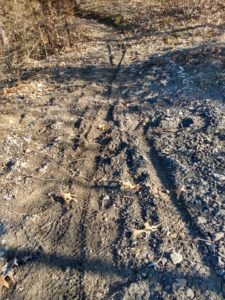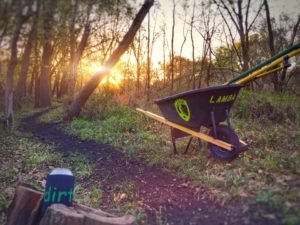Iowa has stellar mountain bike trails and great soil for growing crops. It drains relatively quickly, but if you use dirt trails at the wrong time the consequences can be long term. Translation, our mountain bike trails may take a long time to dry out in the spring/fall, are impacted by the freeze-thaw cycle, and precipitation. The images of mountain bikers splattered with mud and muddy bikes are bad news for Iowa trails, as riding wet trails in Iowa means additional hours of trails maintenance and can impact trail conditions for the rest of the season.
A couple of things to keep in mind as we work our way through spring:
- Frozen dirt is rideable dirt. If you can ride before the thaw begins and the sun touches the trails, you’re in good shape.
- Slick trails mean get off ASAP! You were a bit too long in your ride and you will soon cause damage to the trails as it warms.
- Muddy trails mean stay off, you will cause trail damage. The general rule is if you’re leaving a tire track or footprints, the trail is too wet to use.
- Rain can create variable states of trail readiness – different soil types drain at different rates, even in the same community.
So what happens if you do ride wet trails? Is it really that big of a deal?
A majority of Iowa singletrack trails are maintained by volunteers. These volunteers do most of the trail tread work and fund their work through donations. In the spring, there is quite a bit of maintenance to prepare trails for use, including removal of debris, clearing downed trees, and trail improvements. The same is true after a storm.
When eager users ride/walk/run wet trails, this adds to the maintenance load and may mean a new trail feature or improvement won’t take place. It can also be very challenging to fix trail tread if the tread hardens and all users then have to contend with bumpy and rutted.
How do I find out about trail conditions?
Most local volunteer groups have a social media outlet for updating trail conditions. Some organizations also have a website with trail conditions or a call-in number. Many land managers have signs at the trails explaining trail conditions, and some even note if the trail is open or closed.
I arrived at the trail and couldn’t find a trail condition update, how can I tell if it’s okay to ride?
Take a look around before you venture too far, can you see footprints or tire tracks? Are you leaving either of those? Is there standing water in the parking lot, trailhead, or on the trails? You’ll need to make a quick judgment call.
Bike tire width and air pressure can also make a difference. There may be more leniency riding a fat bike on trails after a rain than riding a gravel bike on the same trails.
While we’re all anxious to get outside and ride dirt, getting out in poor conditions can cause trail damage. If you’re leaving tracks, ride pavement, ride gravel, ride your trainer/rollers, or go for a run.



